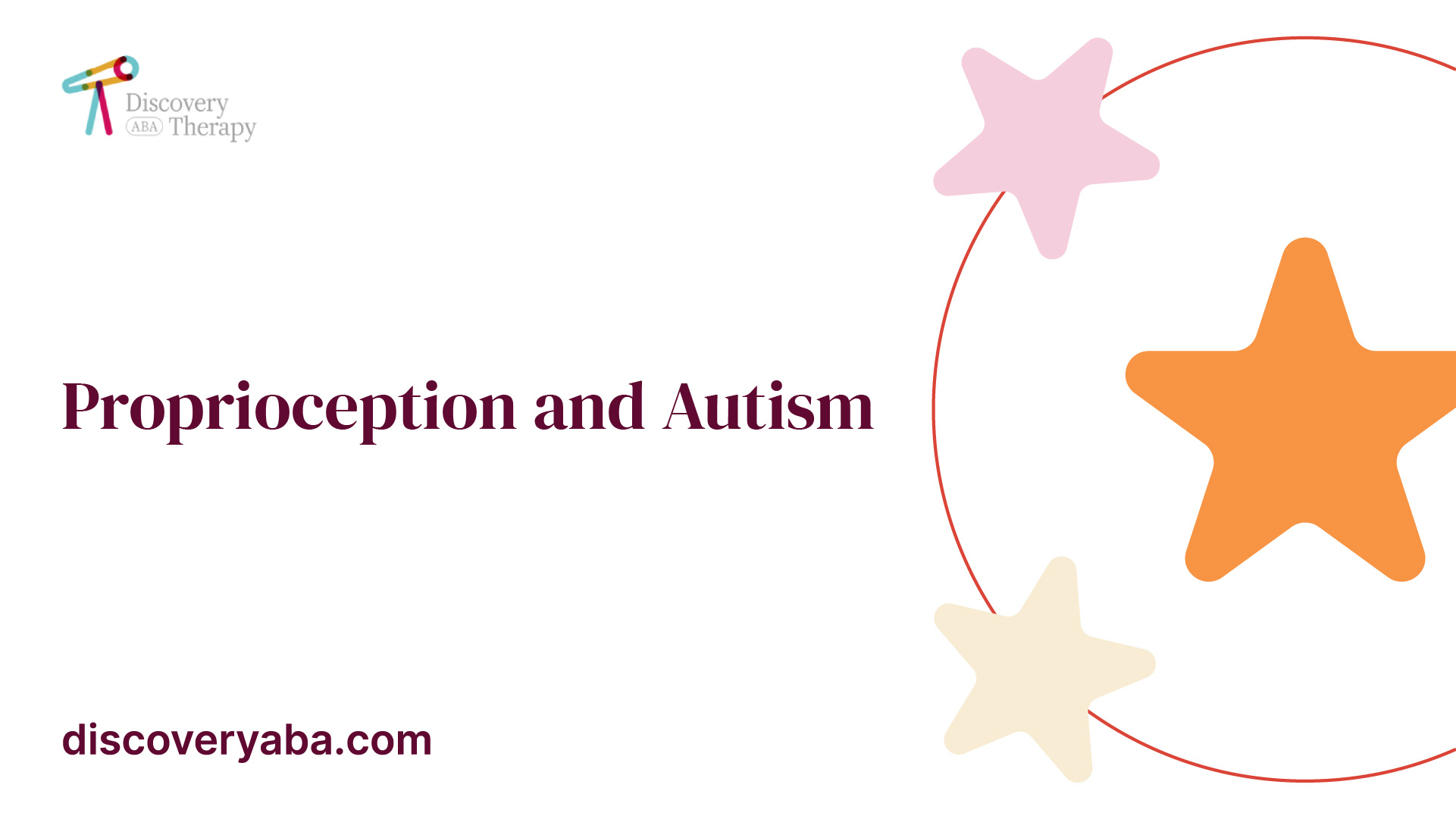Proprioception and Autism
Unlocking the hidden link between proprioception and autism. Explore the impact, challenges, and strategies for managing proprioceptive differences.

Understanding Proprioception
To comprehend the link between proprioception and autism, it is essential to first understand proprioception itself and the benefits it provides. Proprioception, often referred to as the sixth sense, plays a crucial role in providing information about body position in space. It utilizes receptors located in muscles to relay details on muscle length and tension, joint positioning, force against the body, and muscle effort required at any given time [1].
The Role of Proprioceptive Input
In individuals with autism, around 95% of them process sensory information differently, affecting at least one of their eight senses. Proprioceptive input, received from sensory receptors in the skin, muscles, and joints, plays a crucial role in providing the brain with information about movements and body position. This input involves three major components of the brain - the cortex, limbic system, and cerebellum - which collectively affect a child's alertness level, learning, and focused attention.

Benefits of Proprioception
Proprioception offers numerous benefits to individuals with autism. It acts as a natural calming mechanism for an active nervous system, bringing a sense of order and calm when feeling overwhelmed or overstimulated. Here are some key benefits of proprioception:
- Self-regulation: Proprioception is crucial for self-regulation, allowing individuals to maintain an appropriate level of alertness and arousal. This sense helps in managing emotional and behavioral responses to various stimuli, promoting a sense of calm and control.
- Coordination: Proprioception plays a vital role in coordinating movements, improving motor skills, and enhancing overall coordination. It helps individuals with autism to navigate their environment, engage in activities, and develop better body awareness.
- Posture and Body Awareness: Proprioception assists in maintaining proper posture and body alignment. It provides individuals with a better understanding of their body's position in space, enabling them to make necessary adjustments for optimal balance and stability.
- Focus and Attention: Proprioceptive input can help improve attention and focus by enhancing sensory integration and reducing distractions. By providing a sense of grounding and stability, proprioception aids in maintaining attention during academic or daily activities.
- Speech and Language: Proprioception also plays a role in speech and language development. It helps in coordinating the muscles involved in speech production, facilitating clear articulation and fluid communication.
Understanding the role and benefits of proprioception is crucial in recognizing its significance for individuals with autism. By incorporating activities and strategies that provide proprioceptive input, it is possible to support their sensory needs and promote overall well-being.
Proprioceptive Activities for Children with Autism
Engaging in proprioceptive activities can have significant benefits for children with autism. These activities provide proprioceptive input, which refers to the sensory feedback received from the muscles and joints. Proprioceptive input helps individuals better understand the position and movement of their body in space. In this section, we will explore two key benefits of proprioceptive activities for children with autism: improving attention and focus, and addressing challenging behaviors.
Improving Attention and Focus
Proprioceptive activities can be an effective strategy to improve attention and focus in children with autism. Engaging in these activities before tasks or transitions can help prepare the child for what is to come, allowing them to be more attentive and focused. The deep pressure and heavy muscle work involved in proprioceptive activities can help calm the sensory system and promote a state of readiness for learning.
Some examples of proprioceptive activities that can improve attention and focus include:
- Pushing or pulling heavy objects
- Carrying weighted backpacks or bags
- Engaging in yoga or stretching exercises
- Using resistance bands for exercises
- Providing deep pressure input through tight hugs or weighted blankets
By incorporating these activities into a child's routine, particularly before tasks that require attention and focus, parents and educators can help create an optimal state for learning and increase the child's ability to remain attentive and engaged.
Addressing Challenging Behaviors
Proprioceptive activities can also help address challenging behaviors commonly observed in children with autism. The deep pressure and sensory input from these activities can have a calming effect on the nervous system, promoting relaxation, organization, and readiness for daily tasks and challenges.
By providing children with opportunities for heavy muscle work activities or deep pressure input, parents and therapists can offer effective strategies for self-regulation. These activities can help children stay calm, focused, and ready to participate in daily activities.
It is important to note that the specific proprioceptive activities that work best for each child may vary. It is recommended to consult with a therapist or healthcare professional who specializes in working with children with autism to determine the most appropriate activities for addressing challenging behaviors.
By incorporating proprioceptive activities into a child's routine, parents, educators, and therapists can harness the benefits of these activities to improve attention and focus, and address challenging behaviors. The sensory input provided by these activities can have a profound impact on the well-being and daily functioning of children with autism.
Importance of Proprioceptive Processing
Proprioceptive processing plays a crucial role in daily functioning and developmental milestones for individuals, particularly those with autism. Understanding the impact of proprioception can provide valuable insights into the challenges faced by individuals on the autism spectrum and help develop strategies for supporting their needs.
Impact on Daily Functioning
Proprioceptive input, according to Autism Parenting Magazine, can act as a natural calming mechanism for an active nervous system. It helps bring a sense of order and calm when feeling overwhelmed or overstimulated. Engaging in proprioceptive activities can improve attention and focus, making it an effective strategy to prepare individuals with autism for various activities throughout the day.
By providing proprioceptive input, individuals can regulate their sensory system and maintain an optimal state for learning and focused attention. This can be achieved through activities like heavy work breaks, deep pressure input, or engaging in heavy muscle work activities. These activities help individuals with autism navigate their surroundings effectively and enhance their overall functioning.
Developmental Milestones and Self-Regulation
Adequate proprioceptive processing is crucial for developing a sense of self and reaching important developmental milestones. As mentioned by NSPT, occupational therapy can provide valuable insights and assistance in creating a plan for children experiencing challenges in this area.
Proprioception helps individuals with autism develop body awareness and a sense of boundaries. It assists in coordinating movements, improving motor skills, and maintaining proper posture. By enhancing proprioceptive processing, individuals can gain better control over their movements and increase their ability to engage in activities independently.
Understanding the importance of proprioceptive processing allows us to recognize its impact on daily functioning and developmental milestones for individuals with autism. By incorporating activities that provide proprioceptive input, we can support their sensory needs and promote self-regulation, ultimately improving their overall quality of life.
Proprioceptive Dysfunction in Autism
Children with autism often experience challenges related to proprioception, which can have a significant impact on their daily functioning. Understanding the manifestations of proprioceptive difficulties in autism and implementing appropriate strategies is essential for supporting these individuals.
Challenges and Manifestations
Proprioceptive difficulties in children with autism can manifest in various ways. Some common challenges include sensory-seeking behaviors and difficulties with "grading of movement," which refers to the ability to control the force and speed of movements [3]. These difficulties can lead to hyperactive behaviors, as well as lethargy and social difficulties.
Children with proprioceptive dysfunction may seek out excessive movement or pressure to fulfill their sensory needs. They may engage in activities like jumping, crashing into objects, or pushing and pulling heavy objects to stimulate their proprioceptive system. These sensory-seeking behaviors can sometimes be misinterpreted as disruptive or challenging behavior.
On the other hand, some children with autism may struggle with motor coordination and body awareness. They may have difficulties with fine motor skills, such as grasping objects or manipulating tools. These challenges can affect their ability to perform daily tasks and participate in age-appropriate activities.
Strategies for Managing Proprioceptive Difficulties
To address proprioceptive difficulties in children with autism, it is important to incorporate activities that provide proprioceptive input into their daily routines. Proprioceptive activities involve heavy muscle work or deep pressure input to muscles and joints, helping children stay calm, focused, and ready to participate [3].
Here are some strategies for managing proprioceptive difficulties in children with autism:
- Heavy work activities: Engaging in activities that involve pushing, pulling, carrying heavy objects, or climbing can provide the necessary proprioceptive input. These activities can be incorporated into playtime or daily routines.
- Deep pressure input: Providing deep pressure input through activities like tight hugs, weighted blankets, or using therapy tools like therapy balls or weighted vests can help promote a sense of calm and relaxation.
- Sensory breaks: Offering regular breaks during the day for sensory input can help children maintain an optimal state for learning and focused attention. These breaks can include activities like jumping on a trampoline, swinging, or engaging in deep pressure exercises.
- Environmental modifications: Creating a sensory-friendly environment by reducing excessive noises, bright lights, or other overwhelming stimuli can help children with autism better process proprioceptive information.
By incorporating these strategies into daily routines and activities, the challenges associated with proprioceptive dysfunction in children with autism can be effectively managed. It is crucial to work closely with occupational therapists and professionals experienced in sensory integration techniques to develop an individualized plan that addresses the specific needs of each child.
Proprioceptive Processing Differences
Children with autism spectrum disorder (ASD) often exhibit distinct patterns of proprioceptive processing differences compared to typically developing children and those with developmental disabilities. These differences can have implications for motor skills, sensory processing, and overall functioning.
Patterns in Children with ASD
Research has identified specific proprioceptive processing difficulties in children with ASD. According to studies these difficulties include:
- Feedback-Related Motor Planning Skills: Children with ASD may struggle with motor planning skills that rely on feedback from the proprioceptive system. This can affect their ability to execute movements accurately and efficiently.
- Tiptoeing: Many children with ASD exhibit a tendency to walk on their tiptoes. This pattern of walking can be attributed to proprioceptive processing differences.
- Pushing Others or Objects: Some children with ASD may engage in repetitive pushing behaviors. This behavior can stem from difficulties in processing and modulating proprioceptive input.
- Crashing, Falling, and Running: Children with ASD may demonstrate challenges in coordinating movements, leading to an increased risk of accidents such as crashing into objects, falling, or running impulsively.
Understanding these patterns helps professionals tailor interventions and strategies to address the specific proprioceptive needs of children with ASD.
Clinical Applications and Research Directions
The identification of proprioceptive processing differences in children with ASD has important clinical applications. By recognizing these differences, therapists, educators, and caregivers can implement targeted interventions to support proprioceptive development and enhance overall functioning.
Occupational therapy plays a crucial role in addressing proprioceptive difficulties in children with ASD. Therapists use a variety of techniques and activities, such as deep pressure touch, joint compressions, heavy work activities, and sensory integration exercises, to provide proprioceptive input and help regulate sensory processing.
Research in this area is ongoing, with a focus on further understanding the connection between proprioceptive processing differences and the motor and sensory impairments seen in individuals with ASD. Studies aim to explore the underlying mechanisms and identify effective interventions to improve motor skills, sensory integration, and overall functioning in individuals with ASD.
By gaining a deeper understanding of the proprioceptive processing differences in individuals with ASD, professionals can develop targeted interventions and strategies to optimize motor skills, sensory processing, and daily functioning for individuals on the autism spectrum.
Sensory Integration and Proprioception
Understanding the interconnection of senses and the impact on behavior and development is crucial when discussing proprioception in relation to autism.
Interconnection of Senses
Sensory integration focuses on three fundamental senses: tactile, vestibular, and proprioceptive. These senses are interconnected and play a critical role in experiencing, interpreting, and responding to stimuli in the environment. Proprioception, in particular, is a sensory system that allows individuals to perceive and understand their body's position, movement, and location in space. It helps develop body awareness, self-regulation, coordination, posture, and the ability to focus.
Individuals with autism often experience challenges related to proprioception. Dysfunction within the tactile, vestibular, and proprioceptive systems can manifest in various ways, such as over- or under-responsiveness to sensory input, fluctuating activity levels, motor coordination problems, speech/language delays, academic under-achievement, impulsivity, distractibility, lack of planning, and difficulty adjusting to new situations.
Impact on Behavior and Development
Proprioception plays a vital role in the development and behavior of individuals with autism. It provides crucial information about the body's position and movement, allowing individuals to navigate their surroundings effectively. By understanding proprioceptive input, individuals can develop body awareness, a sense of boundaries, and the ability to coordinate movements, improve motor skills, and maintain proper posture.
However, challenges with proprioception can significantly impact individuals with autism. Proprioceptive dysfunction can make it difficult for them to accurately sense movement, leading to difficulties in joint position recognition, balance, and coordination. These challenges can affect various aspects of daily functioning, including motor skills, spatial awareness, and the ability to participate in activities requiring coordinated movements.
Understanding the interconnection between sensory integration and proprioception is essential for individuals with autism. By recognizing and addressing proprioceptive difficulties, appropriate strategies and interventions can be implemented to support their development, behavior, and overall well-being.
References
Find More Articles
Contact us
North Carolina, Tennessee, Nevada, New Jersey, Utah, Virginia
New Hampshire, Maine
Massachusetts, Indiana, Arizona, Georgia
.avif)








































%2520(1).jpeg)































.jpeg)






















